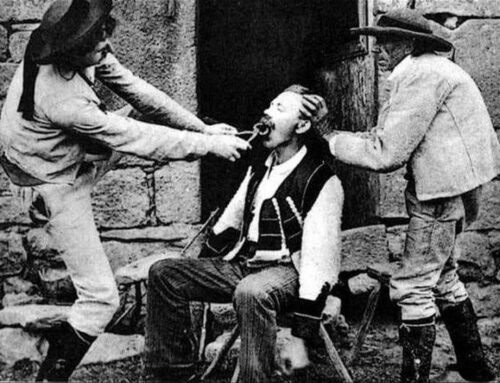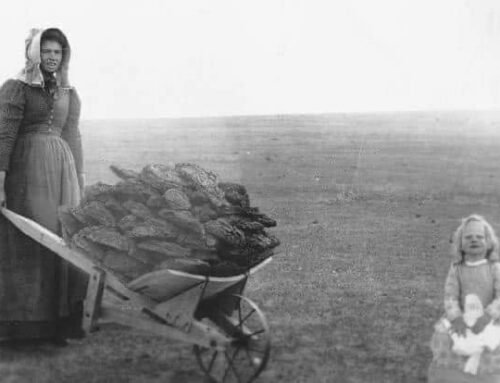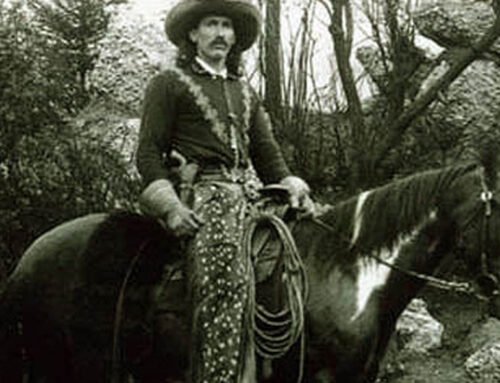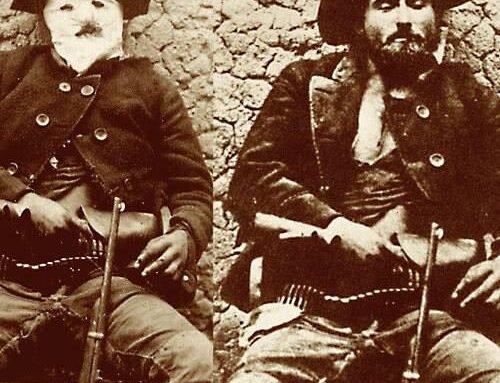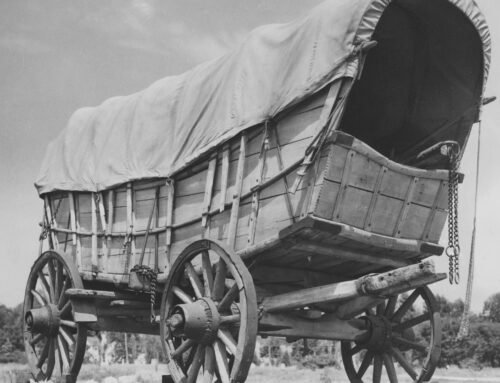Barbed wire: ‘the Devil’s Rope’
By western author Nick Brumby
“Barbed wire is lighter than air, stronger than whiskey, cheaper than dust.”
— Barbed wire promoter John Warne ‘Bet-a-Million’ Gates
 The invention of barbed wire changed the Old West forever. Like the introduction of the six-shooter, the telegraph, the windmill, and the locomotive, barbed wire brought civilisation and ‘fancy society living’ further west than it had ever been before, and tamed ever more tracts of wilderness.
The invention of barbed wire changed the Old West forever. Like the introduction of the six-shooter, the telegraph, the windmill, and the locomotive, barbed wire brought civilisation and ‘fancy society living’ further west than it had ever been before, and tamed ever more tracts of wilderness.
However barbed wire was not welcomed as warmly as revolvers or locomotives. Cattle herders found less space to graze their cattle, as the wire cut off access to public land. In addition, Native American tribes no longer had the freedom to roam the wide unsettled expanses of the West unimpeded. They soon referred to barbed wire fencing the ‘Devil’s Rope’.
Barbed wire, also known as barb wire, is a type of steel fencing wire featuring sharp edges or points arranged at intervals along the strands. Barbed wire was the first wire technology with the strength to restrain cattle. Wire fences are also cheaper and easier to erect than their alternatives.
 Barbed wire changed the very way settlers and grazers used the land. Before barbed wire, livestock grazed freely, competing for fodder and water. Where working farms did exist, most properties were unfenced and open to foraging by roaming cattle and sheep.
Barbed wire changed the very way settlers and grazers used the land. Before barbed wire, livestock grazed freely, competing for fodder and water. Where working farms did exist, most properties were unfenced and open to foraging by roaming cattle and sheep.
The lack of effective fencing limited farming and ranching practices, and the number of people who could settle in an area. Barbed wire changed the West from vast and undefined plains to a land of farming, and widespread settlement.
Wooden fences were costly and difficult to acquire on the prairie, where few trees grew. Lumber was in such short supply that farmers were forced to build houses of sod.

Likewise, rocks for stone walls were scarce out on the plains. Barbed wire proved to be cheaper, easier, and quicker to use than anything else.
The high costs of fencing with lumber can be seen with the first farmers around Fresno, California, who spent nearly $4000 (equivalent to $90,000 today) to have lumber fencing delivered and erected to protect 2,500 acres of wheat crop from free-ranging livestock in 1872.
Wooden fences were time consuming and expensive to erect and also required a lot of maintenance. The value of U.S. fencing stock in 1872 was just about equal to the value of all livestock in the country! The cost of maintaining those fences each year was more than all local, state and federal government tax revenues combined. Barbed wire changed that.
The first patent in the United States for barbed wire[ was issued in 1867 to Lucien B. Smith of Kent, Ohio, who is regarded as its inventor. Michael Kelly made a significant improvement to wire fencing, by twisting two wires together to form a cable for barbs – the first of its kind. Known as the “thorny fence,” Michael Kelly’s double-strand design made fences stronger, and the painful barbs made cattle keep their distance.
 Farmer Joseph F. Glidden of DeKalb, Illinois, received a patent for what became the classic barbed wire design in 1874. Glidden’s design for barbed wire wasn’t the first, but it was the best. As Glidden himself said, “It takes no room, exhausts no soil, shades no vegetation, is proof against high winds, makes no snowdrifts, and is both durable and cheap.”
Farmer Joseph F. Glidden of DeKalb, Illinois, received a patent for what became the classic barbed wire design in 1874. Glidden’s design for barbed wire wasn’t the first, but it was the best. As Glidden himself said, “It takes no room, exhausts no soil, shades no vegetation, is proof against high winds, makes no snowdrifts, and is both durable and cheap.”
The Glidden design saw the barb twisted around a strand of smooth wire, then a second strand of smooth wire was twisted together with the first to stop the barbs from sliding around. American farmers snapped it up.
Glidden’s design invented a method for locking the barbs in place, and invented the machinery to mass-produce the wire. The year that Glidden secured his barbed wire patent, 32 miles of wire was produced. In 1876 commercial production hit 1500 tons, By 1880 about 620,000 miles of barbed wire fences were produced and installed acrooss the Old West. That year, Glidden’s factory in De Kalb turned out 263,000 miles of wire, enough to circle the world 10 times over. By 1900 annual barbed wire production had reached 200,000 tons. By 1910 wooden fences had almost disappeared.
The old-time cowboys also lived on the principle that cattle could graze freely across the plains – this was the law of the open range. The cowboys hated the wire: cattle would get nasty wounds and infections. Other cowmen adopted barbed wire, using it to fence off private ranches. And while barbed wire could enforce legal boundaries, many fences were illegal – attempts to commandeer common land for private purposes.
As barbed wire spread, fights started to break out. Fence cutting wars got so bad that the Supreme Court had to step in and make the crime a felony.
 Surprisingly, one of the biggest changes brought to the West by barbed wire was not to cattle ranching, but to communications. Following the invention of barbed wire in 1874, Alexander Graham Bell invented the telephone two years later.
Surprisingly, one of the biggest changes brought to the West by barbed wire was not to cattle ranching, but to communications. Following the invention of barbed wire in 1874, Alexander Graham Bell invented the telephone two years later.
Telephone networks began to grow at a rapid pace. But telephone companies paid attention only to large cities, bypassing the sparsely populated areas of the American West, because they did not see economic benefits in deploying hundreds of miles of telephone cable.
However, an unknown genius discovered that if two Sears or Monkey Ward telephones were connected to the top wire on a barbed wire fence, people could speak as easily as between two “city” telephones connected via an operator switchboard. The huge networks of barbed wire, stretching for many miles along the farm boundaries, suddenly became an excellent tool for creating private telephone lines.
The technology was very simple. Connecting to the line cost farmers $25. The package included a telephone with two dry batteries, a magneto grounding rod, porcelain caps and tubes, plus 3 yards of wires for internal wiring and more than 15 yards to connect to the line outside the room.
These local ‘networks’ did not have a regular subscription fee. And of course, no one paid any phone bills.
Barbed wire is cited by historians as the invention that tamed the West. Herding large numbers of cattle on open range required significant manpower to catch strays. Barbed wire provided an inexpensive method to control the movement of cattle.
But the beginning of the 20th Century barbed wires’ success made large numbers of cowboys no longer necessary. It truly was the end of an era.

About Nick Brumby
I like a good story. And of all stories, I love westerns the most.
As a kid, I spent far too many afternoons re-watching Clint Eastwood spaghetti westerns, picking up ‘Shane’ for just one more read, or saddling up beside Ben Cartwright when ‘Bonanza’ was on TV each afternoon.
I’m a former journalist and I love horses, dogs, and the occasional bourbon whiskey. I live with my wife, daughter and our ever-slumbering hound in a 1800’s-era gold mining town – our house is right on top of the last working gold mine in the area. There may not be much gold left, but there’s history wherever you look.
I hope you enjoy my westerns as much as I enjoyed writing them!
Happy trails,
Nick






















